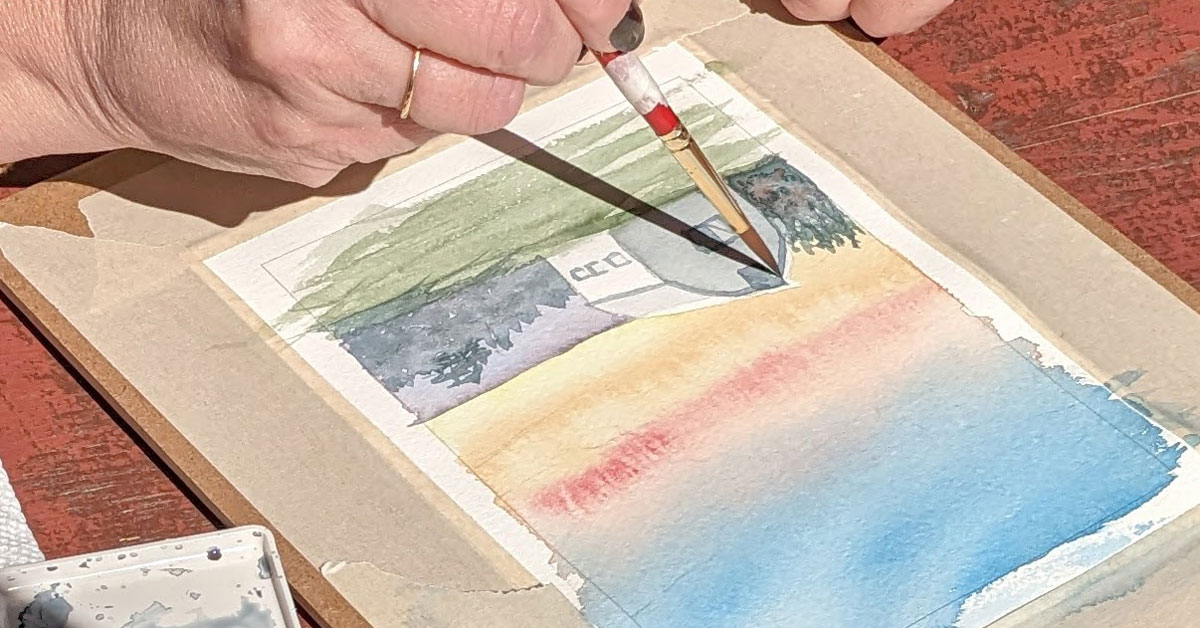
Instruction for painters at different skill levels
Because I don’t have a teaching space of my own, I work with regional organizations in the Potomac Highlands and Eastern Panhandle of West Virginia, Western Maryland, and the Shenandoah Valley of Virginia to offer classes.
If you represent an arts organization that is looking for instructors, I teach several watercolor courses that are especially geared for beginner and emerging painters. I provide courses as single-day workshops and multi-session classes. I also have developed a hybrid mentorship model that uses a mix of video lessons and in-person meetings that is crafted to work best with small groups.
If you are interested in contracting with me to lead a course for your organization, contact me.
For Beginners (no previous experience with watercolor)
Watercolor Foundations – Single-Session Workshop
An 2.5- to 3-hour workshop that provides an introduction to watercolor materials, terminology, basic strokes, washes, and common techniques. After going through an introductory exercise, students use their new skills in completing a small monochromatic landscape painting. The class uses only a single paint color, Sepia, so students can concentrate on managing pigment to water ratios, values, and washes. Sepia makes the landscape painting look like an old-time photograph. If adequate lead time is provided, the scene students complete can be tailored to fit the class location. All materials provided. Limit of 10 students.
Beginner Watercolor – Three- or Four-Session Class Series
A series of classes that introduce beginner painters to the watercolor medium. Early session(s) focus on materials, terminology, basic strokes, washes, and common techniques. After going through an introductory exercise, students use their new skills in completing a small monochromatic landscape painting. The first one to two classes use only a single paint color, Sepia, so students can concentrate on managing pigment load, values, and washes. Sepia makes the landscape painting look like an old-time photograph. Subsequent classes use three primary colors (red, blue, yellow) where students learn color mixing strategies to complete additional landscape and/or floral paintings. All materials provided. Each class meeting lasts approximately 2.5 hours. Limit of 10 students.
Watercolor Play – Single Session
A two-hour workshop that introduces basic watercolor materials and techniques to students and allows them to experiment with primary color mixing and wash applications (wet-on-dry and wet-into-wet) by creating abstracted pattern designs. Pattern ideas are provided, but students are free to make their own once they get comfortable. All materials are provided. Limit of 10 students.
For Emerging Painters (some limited experience with watercolor)
Intermediate Watercolor – Five-Session Class Series
A series of classes that introduce emerging painters to additional design and color-mixing strategies that are tailored for watercolor artists. Early session(s) provide a refresher on materials, terminology, basic strokes, washes, and common techniques. Subsequent classes focus on two strategies for utilizing arbitrary color to paint landscapes and subjects. All materials provided. Each class meeting lasts approximately 2.5 hours. Limit of 10 students.
Sensational Shadows
A one-session workshop that introduces students to the concept of arbitrary color within the framework of three-value compositions. The strategy shows students they can form shadows from mingled washes of transparent colors, which are more visually interesting than allowing vast areas of a painting to be dominated by gray/blue/purple washes. All materials provided. Workshop lasts approximately 3 hours. Limit of 10 students.
Bits and Pieces of the Landscape
An overview of the most common elements found in landscape painting (skies, trees, bricks, stone, water, etc.) and strategies to draw and paint those elements. The techniques are not meant to be the only way to paint a subject, but are intended to be used as tools that can be used when working through problem areas in a painting. Content can be presented as a series of classes or grouped together as a day-long workshop. This course is best for students who have their own supplies and are beginning to work independently.
For Painters Using Any Medium
The 5 Ws of Plein Air Painting: A Design Approach
The 5 Ws are a mnemonic device I’ve developed to help painters slow down and focus while preparing to paint on location (en plein air). In this one-session workshop, we go over the Ws and discuss how they can help lead to a successful painting session, look at some examples of painting designs that used this process, go outside and practice these skills, and then reassemble for some show-and-tell and discussion. As this is a design-oriented workshop, it’s not necessary to bring painting supplies, but students should bring their favorite drawing tools (pencils, pens, markers) and a small sketchbook.
Other Course Options
I have additional course options, including a hybrid mentorship model, so if you are interested in learning more or have a specific request, contact me.
